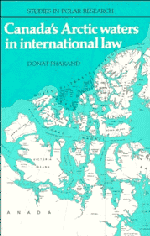Book contents
- Frontmatter
- Contents
- Figures
- Tables
- Foreword
- Preface
- Acknowledgements
- Part 1 The Waters of the Canadian Arctic Archipelago and the Sector Theory
- 1 The origins of the sector theory
- 2 Boundary treaties as a legal basis for the sector theory
- 3 Contiguity as a basis for the sector theory
- 4 Customary law as a basis for the sector theory
- Notes
- Part 2 The Waters of the Canadian Arctic Archipelago as Historic Waters
- Part 3 The Waters of the Canadian Arctic Archipelago and Straight Baselines
- Part 4 The Waters of the Canadian Arctic Archipelago and the Northwest Passage
- Notes
- General Conclusion
- Appendix A The 1825 Boundary Treaty, Great Britain and Russia
- Appendix B The 1867 Boundary Treaty, United States and Russia
- Selected bibliography
- Index
3 - Contiguity as a basis for the sector theory
Published online by Cambridge University Press: 20 January 2010
- Frontmatter
- Contents
- Figures
- Tables
- Foreword
- Preface
- Acknowledgements
- Part 1 The Waters of the Canadian Arctic Archipelago and the Sector Theory
- 1 The origins of the sector theory
- 2 Boundary treaties as a legal basis for the sector theory
- 3 Contiguity as a basis for the sector theory
- 4 Customary law as a basis for the sector theory
- Notes
- Part 2 The Waters of the Canadian Arctic Archipelago as Historic Waters
- Part 3 The Waters of the Canadian Arctic Archipelago and Straight Baselines
- Part 4 The Waters of the Canadian Arctic Archipelago and the Northwest Passage
- Notes
- General Conclusion
- Appendix A The 1825 Boundary Treaty, Great Britain and Russia
- Appendix B The 1867 Boundary Treaty, United States and Russia
- Selected bibliography
- Index
Summary
It is generally recognized that the doctrine of contiguity forms the basis of the sector theory. Even those who invoke the boundary treaties of 1825 and 1867 look to that concept to reinforce their case. This section attempts to determine the extent to which States and international tribunals have relied on contiguity. This is followed by an appraisal of this concept as a principle of international law capable of generating title or sovereignty.
Contiguity in State practice
The notion of contiguity appeared in international law when principles for the acquisition of sovereignty over new territories were being developed. Acquisition through the act of discovery, accompanied by a formal taking of possession, having led to abuses, the Roman Law principle for the acquisition of property was introduced. It required the fulfilment of two conditions: the open intent to occupy (animus) and the actual occupation of a well-defined property (corpus). The second condition being difficult or perhaps impossible to fulfil in many instances, the doctrine of contiguity or geographic proximity was developed.
Under this doctrine, the effective occupation of part of a region or territory gave title to the whole of the unoccupied region or territory proximate enough to be considered as a single geographic unit with the occupied portion. The same doctrine, with the occasional nuance, has been presented under different names, in particular the following: proximity, propinquity, hinterland, adjacency, continuity, geographic unity and region of attraction.
The first use by a State of the doctrine of contiguity seems to have been made in 1844 during the Oregon controversy between the United States and Great Britain.
- Type
- Chapter
- Information
- Canada's Arctic Waters in International Law , pp. 28 - 43Publisher: Cambridge University PressPrint publication year: 1988

